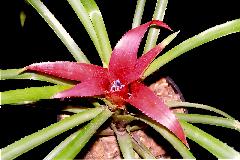
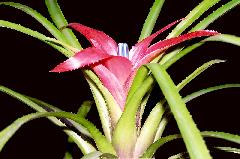
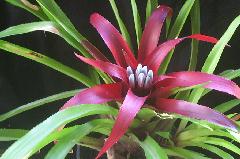
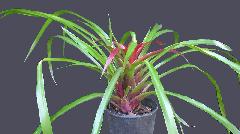
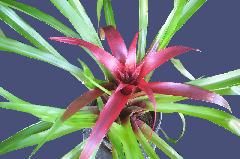
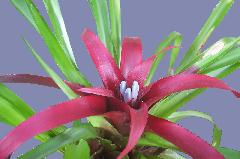
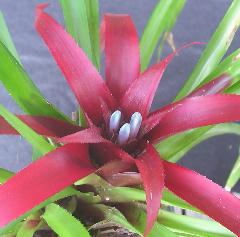
LEAVES 20 to 25, suberect, forming a narrow funnelform rosette;
SHEATHS narrowly oblong-elliptic, 10-13 x 4-6 cm, purplish-wine abaxially, greenish adaxially, densely brown lepidote;
BLADES narrowly linear, slightly if at all narrowed toward base, 25-70 x 1-2 (-2.5) cm, green or purplish mainly toward base, inconspicuously white-lepidote, apex acuminate-caudate, margins densely to subdensely spinulose, spines 0.5-1 mm long, 4-7 mm apart.
SCAPE 6-12 cm long, ca. 0.5 cm in diameter, greenish, lepidote, shorter to nearly equaling leaf sheath length;
SCAPE BRACTS foliaceous, the lower ones exceeding the inflorescence.
INFLORESCENCE bipinnate, obconic, stellate at apex, 6- 7 cm long, ca. 10 cm in diameter, exceeding the leaf sheaths but not notably elevated above the rosette;
PRIMARY BRACTS suberect, inconspicuously lepidote, the lower ones with contrasting sheath and blade, sheaths suborbicular, 3-4 x 4-5 cm, blades narrowly triangular-lanceolate, acuminate-caudate, 4-9 x 1.5-2 cm, purplish or reddish, densely spinulose toward the apex, spines ca. 1 mm long;
FASCICLES ca. 7, the lower ones 3-to-4-flowered, 30-40 x 15-25 mm;
FLORAL BRACTS ovate-lanceolate, apex acute and apiculate, subentire to densely spinulose near the apex, 20-30 x 10-17 mm, white-lepidote, equaling the middle of the sepals.
FLOWERS sessile, 4-5 cm long;
SEPALS elliptic or long ovate, apex acute or subacute and apiculate, 18-24 x 5-7 mm, connate for 6-10 mm, glabrous, green or reddish toward the apex;
PETALS 30-40 mm long, connate for 22-30 mm, lobes 8-10 x 5 mm, blue, bearing 2 small callosities at base;
ANTHERS the antepetalous ones ca. 7 mm long, the antesepalous ones ca. 6 mm long, apex apiculate;
STIGMA subglobose, ca. 1.5 mm long;
OVARY subclavate, ca. 15mm long, 5-6 mm in diameter, white toward apex and bluish near the base.
FRUITS purplish toward base, dark brown at apex, persistent calyx dark brown at base, toward apex whitish on sepal keels and purplish along their margins.
TYPE. Espirito Santo, Cariacica, 1982, A. Seidel 794. Holotype. HAL. Clonotype HB.
DISCUSSION
Nidularium cariacicaense was originally created by Wilhelm Weber of the former German Democratic Republic as a variety of N. Procerum to which it is indeed related morphologically. However, after analyzing the holotype, deposited in the herbarium of Martin-Luther University, Halle, Germany, and also a clonotype supplied by Alvim Seidel, collector of the type specimen, as well as numerous live plants and herbarium sheets, it was clear that this taxon is endowed with a suite of characteristics that validate its recognition as a species.
This species differs from N. Pracerum in its leaf configuration characterized by very narrow leaves and primary bracts. This trait draws it closer to N. Angustibracteatum which is found mainly in southern Rio de Janeiro state and in Sao Paulo. Nidularium cariacicaense differs from the latter not only in its geographic range, concentrated in Espirito Santo, but also in its triangular to ovate-lanceolate floral bracts, wider at the base and equaling the middle segment of the sepals. Its sepals are also acute or subacute (not narrowly acuminate), more highly connate at the base and not distinctly carinate. The floral bracts of N. Cariacicaense vary from nearly entire to densely spinulose at the apex. This variation and the delicate aspect of some specimens, which may even have green to purplish-wine leaves, has led to confusion of this species with N. Scheremetiewii in the past.
DISTRIBUTION & HABITAT
This species is endemic to Espirito Santo where it lives in the Atlantic forest from 80 to 700 m altitude. Today it is more common in montane regions of the state, especially Domingos Martins, Santa Leopoldina and Santa Teresa, because the forests of these areas are better preserved than those of lower elevations around Cariacica. It grows mostly as an epiphyte forming dense clumps on the lower part of tree trunks.
Nidularium cariacicaense is preserved in the wild in the Santa Lucia Biological Reserve in Santa Teresa. It flowers from March to May and is well represented in cultivation by about four distinct clones.
TYPE: Sao Paulo, Ubatuba, L. K. C. de Araujo s. n. legit, fl. cult. 25 May 1986, E. Leme 750. Holotype. HB. Isotypes: RB, WU, SEL.
DISCUSSION
In spite of the typically delicate aspect of this species with its very narrow leaves and bracts, N. angustibracteatum belongs to "subcomplex procerum".
It is easily confused in outward appearance with N. cariacicaense from Espirito Santo that has the same leaf configuration.
The most important differentiating traits of N. angustibracteatum are the narrowly triangular floral bracts surpassing the middle of the sepals and the narrowly lanceolate sepals more shortly connate at the base with a pronounced keel.
Some populations of N. angustibracteatum may have more robust specimens (e. g., Leme 4749, 4753) that differ slightly from the normal species pattern (e.g. Leme 4758). These more robust plants with shorter leaves usually grow where there is more sunlight. However, both the typical specimens and the more robust specimens maintain their individual traits when grown in a uniform environment.
DISTRIBUTION & HABITAT
The most important populations of N. angustibracteatum are concentrated in the southernmost sector of Rio de Janeiro state in Parati municipality and along the coast of Sao Paulo. Its nearest relative (i.e. N. cariacicaense) occurs much farther north in Espirito Santo. In Sao Paulo the distribution of N. angustibracteatum gradually thins out farther south and is residual in Parana and Santa Catarina.
This species is an epiphyte in the deep shade of the Atlantic forest understory from the coastal plains to nearby mountain slopes. It flowers from February to May, and is represented in cultivation by several clones.